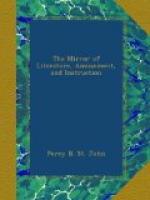The best or north-east view of Carmarthen comprises the bridge, part of the quay, with the granaries and shipping, and in the middle is seen part of the castle. Few towns can, perhaps, boast of greater antiquity, or of so many antiquarian remains as Carmarthen, South Wales; although, I am sorry to say, that their origin and history have not been, I believe, clearly explained or understood by the literary world. One would conclude, that as a Welshman is almost proverbially distinguished for deeming himself illustriously descended, and relating his long pedigree, he would naturally boast of, and exhibit to the public, some account of these vestiges of his ancestors; but such is not the case, and to their shame be it spoken, these ruins are scarcely noticed with any degree of interest by the inhabitants of Carmarthen. But to my subject. The name is derived from caera, wall, and marthen, a corruption of Merlyn, the name of its founder, who was a great necromancer and prophet, and held in high respect by the Welsh. There is a seat hewn out of a rock in a grove near this town, called Merlyn’s Grove, where it is said he studied. He prophesied the fate of Wales, and said that Carmarthen would some day sink and be covered with water. I would concur with the author of a “Family Tour through the British Empire,” by attributing his influence, not to any powers in magic, but to a superior understanding; although some of his predictions have been verified. The town of Carmarthen is pleasantly situated in a valley surrounded by hills; it has been fortified with walls and a castle, part of which remain; so that it appears to have been the residence of many princes of Wales. It has also been a Roman station, and has the remains of a Roman praetorium. Amongst its other antiquities are the Grey Friars, (a monastery,) the Bulwark, (a trench on the side of the town that fronts the river,) and the Priory. Its modern buildings are, the monument erected to Sir Thomas Picton, the Guildhall, the two gaols, a fish and butter market-place, over which is the town fire-bell; the slaughter-house, similar to the abattoir at Paris, and excellent shambles, with poultry and potato market-places annexed. The church, which is an ancient one, has an unattractive exterior; but when you enter it, I think you will say it can compete with any church for ancient beauty and ornament. Amongst the tombs in the chancel are those of Sir Rhys ap Thomas, with the effigies of him and his lady, affording a specimen of the costume of the reign of Henry VII.; and Sir Richard Steele, whose remains are discovered by a small, simple tablet. There is a promenade here, called the Parade, which commands a fine and extensive view of the surrounding picturesque scenery and of the Towy, where the coracles may be seen plying about. The town consists of ten principal streets, noted for being kept clean, and lighted with gas. It is governed by a mayor, two sheriffs, and twenty councilmen; sends a member to Parliament, and gives




